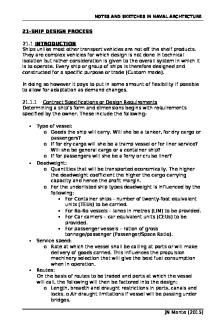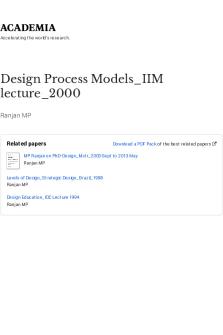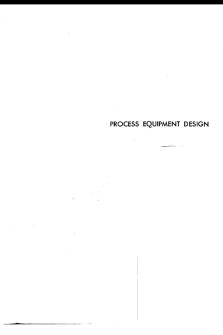Lecture Notes 1 - Design Process, Design to Cost PDF

| Title | Lecture Notes 1 - Design Process, Design to Cost |
|---|---|
| Author | failincorporated inc |
| Course | Design For Manufacturability |
| Institution | University of Illinois at Urbana-Champaign |
| Pages | 16 |
| File Size | 1.5 MB |
| File Type | |
| Total Downloads | 72 |
| Total Views | 147 |
Summary
lecture notes from 2018, me270, lecture notes 1....
Description
1
Function, Quality, and Cost Design Process
Lecture Notes 1: The Design Process; Design-to-Cost
What is a “Product Design Specification” (PDS)? Concurrent Engineering aPriori Cost Analysis Manufacturing Process Selection
2
ME 270, Leon Liebenberg
Key steps in Design for Manufacturability
3
Manufacturing Principles, Methods, and Equipment
Hierarchy of manufacturing processes: • What is theoretically possible (“in principle”) ? • What is practically possible (“method”)? • What is possible with the equipment used for that method?
4
ME 270, Leon Liebenberg
Function, Quality, & Cost • Matching design requirements to suitable manufacturing processes is at the heart of design-for-manufacturability • Trade-off! • In this course, we will usually analyze design requirements and related manufacturing processes i.t.o. function, quality, and cost
5
Inputs to the Design Process
6
ME 270, Leon Liebenberg
Stages of the Design Process Identify Need
Ideation
Develop Product Design Spec
Generate Design Ideas
Analyze and Select Design
Identify Need Need: driven by marketing or business plan, customer request, cost reduction, or desired design improvement
Detail Design Prototype Development
Iterate any steps, as necessary
Do Background Research
Build Prototype Evaluate
Manufacture
7
Stages of the Design Process Identify Need
Ideation
Develop Product Design Spec
Generate Design Ideas
Analyze and Select Design
Detail Design Prototype Development
Iterate any steps, as necessary
Do Background Research
Build Prototype Evaluate
Manufacture
8
ME 270, Leon Liebenberg
Do Background Research Background: What is currently available? What is the competition? Perform benchmarking, patent search.
Stages of the Design Process Identify Need
Ideation
Develop Product Design “Spec”
Develop Product Design Spec
Product Design Specification (PDS) • Identify product/design requirements • Review all 28 Primary Elements from performance through cost, to disposal/recycling requirements • Objective/measurable - with units (metrics) For example: • Able to support 500 N of vertical force • Produce flow rate of 200 l/s • Maintain operating temperature of 32ºC • Requires no tools for assembly
Generate Design Ideas
Analyze and Select Design
Detail Design Prototype Development
Iterate any steps, as necessary
Do Background Research
Build Prototype Evaluate
Manufacture
9
Primary Elements of PDS
AESTHETICS
INTELLECTUAL PROPERTY
TESTING
COMPANY CONSTRAINTS
PROCESSES QUALITY & RELIABILTY
ERGONOMICS
DISPOSAL MARKET CONSTRAINTS
TIMESCALES
CUSTOMER SAFETY STANDARDS PRODUCT LIFE SPAN
PRODUCT
ENVIRONMENT QUANTITY
TARGET PRODUCT COST
MANUFACTURING FACILITY
ME 270, Leon Liebenberg
LIFE IN SERVICE SHIPPING
COMPETITION
10
MAINTENAMCE SHELF LIFE
PERFORMANCE
ETHICS & SOCIETY
MATERIALS
SIZE & WEIGHT
PACKAGING
Primary Elements of PDS – ME 270
11
PDS comparison for ME 170, 270, 370, & 470 ME 170
ME 270
ME 370
ME 470
12
ME 270, Leon Liebenberg
Stages of the Design Process Identify Need
Ideation
Develop Product Design Spec
Generate Design Ideas
Analyze and Select Design
Detail Design Prototype Development
Iterate any steps, as necessary
Do Background Research
Build Prototype Evaluate
Manufacture
Generate Design Ideas Idea generation: • BRAINSTORMING – use mult. tools • SKETCH IDEAS – initial simple 2D, then Refine to 3D • Rough Prototyping with expendable materials (e.g. paper, cardboard, foam),
Rules of Ideation • • • •
No criticism or ridicule Free flow of ideas Record ALL suggestions Do not prejudge idea
13
Stages of the Design Process Identify Need
Ideation
Develop Product Design Spec
Generate Design Ideas
Analyze and Select Design
Detail Design Prototype Development
Iterate any steps, as necessary
Do Background Research
Build Prototype Evaluate
Manufacture
14
ME 270, Leon Liebenberg
Analyze and Select Design • Preliminary design evaluation and calculations • Use structured concept selection process (e.g. Pugh chart/matrix) • Present to client and explain/defend decision
Stages of the Design Process Identify Need
Ideation
Develop Product Design Spec
Generate Design Ideas
Detail Design
Analyze and Select Design
Detail Design Prototype Development
Iterate any steps, as necessary
Do Background Research
Build Prototype Evaluate
• CAD (Detailed engineering drawings) • Analysis: Use analytical and computational tools • Bill of Materials
Manufacture
15
Stages of the Design Process Identify Need
Ideation
Develop Product Design Spec
Generate Design Ideas
Analyze and Select Design
Detail Design Prototype Development
Iterate any steps, as necessary
Do Background Research
Build Prototype Evaluate
Manufacture
16
ME 270, Leon Liebenberg
Build Prototype Evaluate Prototyping and Evaluation: • Measure performance • Does it work as predicted? • Compare against design specs & pre-set metrics • Redesign prototype as necessary • Debug prototype and manufacturing processes. • Determine prototype vs. production cost … is it scalable?
Stages of the Design Process Identify Need
Ideation
Develop Product Design Spec
Generate Design Ideas
Analyze and Select Design
Detail Design Prototype Development
Iterate any steps, as necessary
Do Background Research
Build Prototype Evaluate
Manufacture
17
“Design Thinking”
18
ME 270, Leon Liebenberg
Manufacture • ME 170/270: Mass Production • ME 470: Production for Client Needs
Knowledge and Learning Marketing Knowledge
Cost of Change
High 0
Percentage
100 90
0 0
Knowledge of Design Behavior
80 70
0 0
60 50
0 Process 0 Capability 0 Knowledge 0
40 30 20 10
Design Freedom to Make Changes
0
Low
Time Into the Design Process
Production
19
Why DtC? Prior to the early 90’s Marketing
Design
Manufacturing
Cost Calculation
Cost as a design factor starting to surface Marketing
Conceptual Design
Detailed design
Process Selection
Cost Estimate
70% product cost is committed at early stages of design, only 6% of development cost is spent on design itself… 20
ME 270, Leon Liebenberg
Concurrent Engineering “Concurrent engineering” = Simultaneously doing product design + design of manufacturing system
Marketing Knowledge
Cost Knowledge
Material Choice
Product Idea
Mfg. Process Selection
Detailed Design Dev.
21
Design to Cost - Implementation Goals: • Estimating cost directly from a part model’s geometric features • In real-time during CAD modeling with little to no extra time and without expert manufacturing knowledge • In an integrated environment with direct access to enterprise cost data (e.g. updated material cost, machine parameters, labor rates, overhead rates, etc.)
22
ME 270, Leon Liebenberg
Cost Analysis • Variable Cost
• Fixed Cost
– Costs that vary with the amount of product output
– Costs that are independent of
• If your company is a bakery, which are fixed costs: flour
light bulbs
cupcake holders
oven energy
capital depreciation
boss’ salary
building rent
• Fully Burdened Cost – Combination of Fixed and Variable costs on a per part basis ME 270,
© 2015 University of Illinois at Urbana-Champaign, All Rights Reserved
23
Product Cost Components Cost breakdown of a bicycle
24
ME 270, Leon Liebenberg
slide 23
Cost Factors Why is die casting more costly than sand casting?
Tooling is a lot more expensive and labor costs are roughly double 25
Cost Factors When to choose automated machining?
Automated machining moves costs from labor to tooling 26
ME 270, Leon Liebenberg
Manufacturing Process Selection
27
Examples of Costs: Sand Casting
28
ME 270, Leon Liebenberg
Examples of Costs: Machining
29
Examples of Costs: Injection Molding
30
ME 270, Leon Liebenberg
Example: A Classification of Manufacturing Processes Familiar groupings of manufacturing processes. Final column = a list of possible attributes for a specific process.
31
ME 270, Leon Liebenberg...
Similar Free PDFs

Process Design
- 6 Pages

Complier design - Lecture notes 1
- 65 Pages

Study Design - Lecture notes 1
- 7 Pages

Piping design - Lecture notes 1
- 15 Pages

-Ship Design Process
- 1 Pages

Design 1 Notes
- 10 Pages

Aircraft design - Lecture notes 5
- 104 Pages

Training design process of Nestle
- 13 Pages
Popular Institutions
- Tinajero National High School - Annex
- Politeknik Caltex Riau
- Yokohama City University
- SGT University
- University of Al-Qadisiyah
- Divine Word College of Vigan
- Techniek College Rotterdam
- Universidade de Santiago
- Universiti Teknologi MARA Cawangan Johor Kampus Pasir Gudang
- Poltekkes Kemenkes Yogyakarta
- Baguio City National High School
- Colegio san marcos
- preparatoria uno
- Centro de Bachillerato Tecnológico Industrial y de Servicios No. 107
- Dalian Maritime University
- Quang Trung Secondary School
- Colegio Tecnológico en Informática
- Corporación Regional de Educación Superior
- Grupo CEDVA
- Dar Al Uloom University
- Centro de Estudios Preuniversitarios de la Universidad Nacional de Ingeniería
- 上智大学
- Aakash International School, Nuna Majara
- San Felipe Neri Catholic School
- Kang Chiao International School - New Taipei City
- Misamis Occidental National High School
- Institución Educativa Escuela Normal Juan Ladrilleros
- Kolehiyo ng Pantukan
- Batanes State College
- Instituto Continental
- Sekolah Menengah Kejuruan Kesehatan Kaltara (Tarakan)
- Colegio de La Inmaculada Concepcion - Cebu







